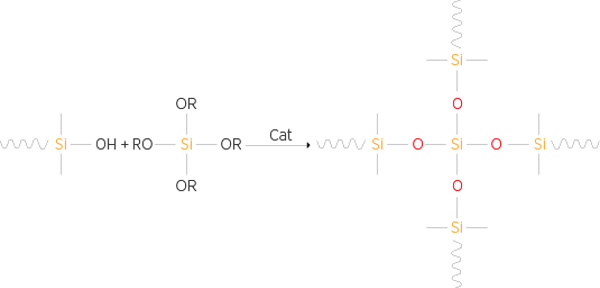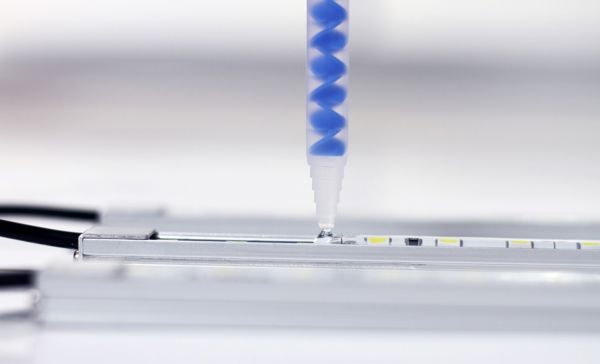什么是RTV-2硅橡胶?
RTV-2硅橡胶是双组分室温硫化硅橡胶、凝胶或泡沫。该体系的每个组分都包含交联剂或催化剂,将两个组分混合后可以发挥预期的性能。其配方可以定制,以满足对粘度、附着力、机械性能、耐化学性或耐温性的不同要求。

化学结构
RTV-2硅橡胶通常呈液态或糊状,在室温下混合和固化后,可以形成三种不同物理形态的产物:固体弹性体、凝胶和柔性泡沫。RTV-2硅橡胶一般由线性聚硅氧烷、增强矿物填料或有机硅树脂、交联剂、催化剂和抑制剂构成,抑制剂的作用是控制混合物的适用期,确保其加工性能。将两种组分混合后,在有机锡催化剂作用下通过缩合反应发生交联,产生醇副产物,或者在铂金催化剂作用下通过加成反应发生交联,不产生任何副产物。该行业的最新趋势之一是采用其他有机化合物替代有机锡催化剂。
RTV-2硅橡胶的特性
RTV-2硅橡胶具有诸多优异的特性,使其在较大温度范围内具有极佳的稳定性,弹性体配方可在-80°C至+ 250°C温度下保持柔性,一些配方能够耐受短时间暴露于高达300°C温度下。另一方面,一些类型的RTV-2硅橡胶可以承受-100°C的温降。当温度高于350°C时才会分解,产生不易燃且不可燃的惰性二氧化硅沉积物。
一些具有良好导热性和介电性能的配方特别适合用于高效电绝缘应用,不会发生热积聚。与具有相同功能的其他材料(如聚氨酯)相比,RTV-2硅橡胶在耐热性方面具有明显优势,而且其防火性在有机硅配方中也是非常出色的,防火性是电气系统的常用防护性能指标。而与环氧树脂等其他材料相比,有机硅具有极大的灵活性,在差胀过程中不会对电子元件产生应力(有机硅凝胶在此方面的性能更好)。耐受性包括能够承受长时间暴露于恶劣大气条件下。此外,硅橡胶还具有良好的机械性能及低表面张力,能够精确复制表面细节,从而成为了模塑应用的首选材料。许多RTV-2配方提供出色的离型性能,优于有机和无机材料的固化橡胶,是模塑成型、印刷和原型制作应用的理想材料。
修订表
技术
RTV-2
定义
RTV-2(双组分室温硫化)硅橡胶是通过将基胶与固化助剂结合制成的硅橡胶配方。其固化方式为:将两种组分混合后,在有机锡催化剂作用下通过缩合反应发生交联,或者在铂金催化剂作用下通过加成反应发生交联。
基本信息
RTV2硅橡胶的粘度/硬度范围为柔软~中等硬度,通常为15 - 40 Shore A。
典型特性
RTV2硅橡胶具有诸多优点,包括易于使用和加工,低粘度,良好的流动性,低收缩率,不变形,硬度可定制,可耐受高温和低温,具有耐酸性和耐碱性,采用RTV2硅橡胶制成的产品非常持久耐用。
固化机理 (加聚)

固化机理 (缩聚)

加工性能
利用特定的工艺和设备将 原料混合后,进行固化。
应用/最终产品
RTV-2硅橡胶可用于纺织涂层、模具制造、离型涂层、3D打印或增材制造,驾驶舱仪表,发动机电子元件灌封,密封。
了解我们的最新视频 "RTV-1 和 RTV-2 有机硅的区别是什么?
为何使用RTV-2硅橡胶?
在医疗行业,我们的RTV-2生物相容性硅橡胶可用于生产医用有机硅粘合剂,这种粘合剂应用于皮肤护理产品(如:伤口护理绷带和无菌敷料,基于PU薄膜、针织布或无纺布等多种基材)以及固定医疗器械。绷带和其他伤口护理产品易于更换敷贴部位,可长时间保持粘附性,而且易于撕除无痛感,新长出的皮肤组织不会与疏水性有机硅粘合剂发生粘连。
RTV-2硅橡胶在这些应用中展现出诸多优势,因为其具有良好的机械性能:粘性佳,优异的剪切性能,持久的剥离强度(附着力)。为了满足制造商的应用需求,可以根据其生产环境对RTV-2硅橡胶配方进行定制设计。
与RTV-1硅橡胶相比,RTV-2硅橡胶具有以下优势:
- RTV-2硅橡胶固化更快
- 可通过提高环境温度来稍微加快交联
- 可实现厚涂层固化
- 可提供易流动、自流平和防流挂的配方
- 自粘配方对多种基材具有出色的附着力
相关应用

RTV-2硅橡胶广泛用于诸多行业和应用,可用于生产柔性模具,这些模具用于制造工业设备和医疗器械的各种技术零件和机械零件。RTV-2硅橡胶不仅可用作制造产品的基料,也可用于生产模具、脱模剂和粘合剂等。RTV-2硅橡胶弹性体可用于封装和灌封高科技工业和科研设备的电子元件,也可用于纺织品涂层。
相关产品
联系我们
与全球领先的材料制造商携手,将您的企业提升到一个新的水平。